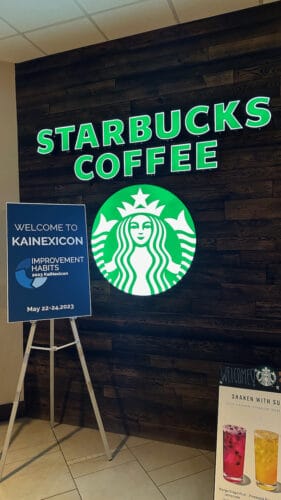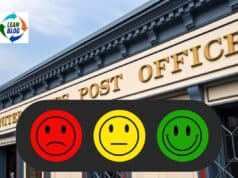When I was at KaiNexicon last week, our hotel in Austin had a Starbucks in the lobby. I'm a pretty regular drinker of the Nitro Cold Brew beverage at Starbucks or other coffee shops when I can find it. I like the soothing cool drink on a warm day. Cold brew coffee (in regular or nitrogen-infused) form is also easier on my stomach since it's less acidic.
One morning, I ordered the Grande Nitro Cold Brew with a splash of heavy cream. I didn't watch the drink being made, but when they called out my name, I noticed that the drink had ice — which is not the standard, and it's not my preference.
Because of the heavy cream (which I don't always add, doing so here because I wasn't really having breakfast), I couldn't tell if it was regular cold brew (which is supposed to have ice) or if they put ice in the Nitro.
I politely pointed out the mistake. “No, I ordered Nitro but there's ice in there,” is what I said (I think).
It's OK, these things happen. It's nothing that merits getting upset about. The barista apologized and said it would be just a minute to remake it properly.
As the barista made the drink again, she poured the Nitro, but then dumped ice into the cup. I wasn't able to stop her. I explained, and then a manager or lead barista chimed in that Nitro isn't supposed to have ice.
On the third attempt, she poured Nitro, about two thirds of the way up the cup. The barista, to her credit, started asking that other employee how much heavy cream was a “splash.” She was coached, “No not that much… adding that much would be nasty to drink.”
The barista added the proper splash (which seems to be a true “splash” rather than a measured amount) and then popped up the drink with enough Nitro to make a full 16 ounces.
If the barista had just plowed ahead, it might have required a fourth attempt to get it right.
The barista apologized to me again and said,
“I'm new, it's my second day.”
Instead of blaming the barista, I'll point to systems problems at Starbucks. There seemed to be a real training and education gap.
It's a shame that the store seems not to be reaping any benefits from the era when Starbucks was keen on Lean, including their utilization of the wonderful “Training Within Industry” approach to structured and effective training.
See this article from LEI about TWI and Starbucks.
I interviewed former Starbucks leader Karen Gaudet about this and her book back in 2020:
It's a shame that this location seems to be practicing a haphazard “Training By Correcting Mistakes” approach. Is the cost of wasted beverages higher than the cost of taking the time to do training in a structured way, where the learning is confirmed properly?
In recent articles about the new Starbucks CEO Laxman Narasimhan working in stores, he received 40 hours of “certified barista” training — and that was stated to be the norm. But maybe not everybody is a “certified barista.”
As I discuss in my book The Mistakes That Make Us: Cultivating a Culture of Learning and Innovation, we can realize:
- We all make mistakes, especially when trying something new
- That said, it's usually helpful to work to prevent mistakes (through methods including training and checklists)
- When people aren't sure how to do something, I hope they feel enough “psychological safety” to ask somebody their question or to ask for help
- If a mistake happens (due to a lack of knowledge, forgetting how to do something, or just slipping up), focus on learning instead of punishment
The situation at Starbucks could have been worse. Thankfully, I don't think the barista got yelled at or punished. I'm guessing that her lessons learned will stick with her, such as:
- No ice in Nitro Cold Brew
- How much a “splash” of heavy cream is
I'm sure the “learning through mistakes” approach causes some level of stress and embarrassment, even if there's no overt punishment.
I don't know if this hotel location is representative of Starbucks as a whole. I don't want to make the mistake of extrapolating from one experienced at a single store.
But I do wonder what happened to Lean and TWI at Starbucks?
Please scroll down (or click) to post a comment. Connect with me on LinkedIn.
Let’s build a culture of continuous improvement and psychological safety—together. If you're a leader aiming for lasting change (not just more projects), I help organizations:
- Engage people at all levels in sustainable improvement
- Shift from fear of mistakes to learning from them
- Apply Lean thinking in practical, people-centered ways
Interested in coaching or a keynote talk? Let’s talk.
Join me for a Lean Healthcare Accelerator Trip to Japan! Learn More











TWI is such a great process. It was the second most valuable thing I learned at Toyota. The most valuable was problem solving and TWI is a solution tool. Every company I ever worked with said they did not do a good job of training and yet very few want to master Job Instruction Training. Part of the reason is that the original methods were developed around WWII time and work was simpler then and the method was based on work that might have a few steps to assemble something and then repeat. Fine if you work in an assembly plant with repeating work, but the work of a Barista is not a series of steps repeated.
People have a difficult time teaching a non-cyclical task so what they do is tell the trainee “everything you need to know” and then they are “trained.” I call it microwave training. A minute and a half and you are good to go.
We should do a podcast on this subject as it affects all businesses.
Thanks for your thoughts, David.
Good point about TWI, but Starbucks could still use many of the principles even when the work isn’t so repetitive.
Are they doing “TWI”-level training, bad training, or no training?
For this barista… it felt like “no formal training.” That can’t be fun, even if her mistakes are being responded to in a kind manner.
Comments are closed.